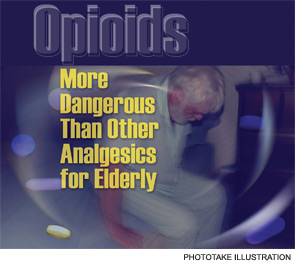
In the past few years, the use of opioids to treat arthritis pain has increased dramatically because of concerns with the risk of cardiovascular disease and other side effects with nonselective, nonsteroidal antiinflammatory drugs (nsNSAIDs) and selective cyclooxygenase-2 inhibitors (coxibs). Despite the widespread use of these agent, there have been few data available on the comparative safety profile of opioids. Now, two studies by Solomon et al published in the Archives of Internal Medicine show that elderly patients who take the narcotic-based drugs are at higher risk of cardiovascular disease, fractures, and death when compared with individuals taking nsNSAIDs and coxibs.1,2
“We were motivated to study this area because of a dramatic increase in opioid use and professional society recommendations, but there was a general lack of data about the comparative safety of opioids in older adults,” says lead author Daniel Hal Solomon, MD, MPH, associate professor of medicine in the Division of Pharmacoepidemiology and Rheumatology at Brigham and Women’s Hospital at Harvard University in Boston. Dr. Solomon is also a member of the Editorial Board of The Rheumatologist.
The researchers studied the claims database of 12,840 Medicare patients in Pennsylvania and New Jersey from 1999 through 2005, comparing the use of nsNSAIDs, coxibs, and opioids. The patients in this study had been diagnosed with either rheumatoid arthritis or osteoarthritis. Safety events reviewed included cardiovascular problems (myocardial infarction, stroke, heart failure, revascularization, and out-of-hospital cardiac death), gastrointestinal tract outcomes (upper and lower gastrointestinal-tract bleeding and bowel obstruction), acute kidney injury (including hospitalizations for acute renal failure requiring dialysis), hepatic toxic effects (including inpatient and outpatient events), fractures (hip, pelvis, wrist, and humerus, but not spine), and trauma denoting a fall.
The Results
“In a cohort of older adults with arthritis, opioid users experienced the highest risk across most specific and severe safety events and nsNSAID users the lowest risk,” the authors wrote in the article titled, “The Comparative Safety of Analgesics in Older Adults with Arthritis.” “The three composite severe safety events that we defined—events leading to hospitalization, events associated with death, and all-cause mortality—mirror serious adverse events as defined by the U.S. Food and Drug Administration [FDA].”
In an invited commentary that followed this first article, Jonathan Graf, MD, assistant adjunct professor of medicine at the University of California, San Francisco, noted that, “evidence suggests that the greatest increase in prescriptions for opioids is occurring in women with chronic pain who are older than 65 years … Use of opioids is potentially problematic in this particular population that is more prone to cognitive impairment, falls, and respiratory depression, which is why the study of Solomon et al is of particular interest.”3


